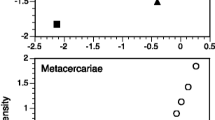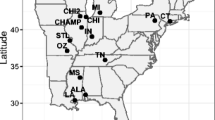Abstract
Positive relationships are commonly observed between the abundance of a species in a locality and the frequency of its occurrence among localities on a larger scale. This pattern may not hold for parasitic organisms when the average abundance of a parasite among its hosts is related to the number of host species in which it occurs, because of the additive investment in specific adaptations to counter host immune responses required for each host species in a parasite’s repertoire. For a rigorous test of the hypothesis that there is a trade-off between the number of host species that can be successfully exploited and the average abundance of parasites in those hosts, one needs to take into account the phylogenetic (or taxonomic) distances among the host species used by a parasite. Differences in immune responses are likely to increase with increasing phylogenetic distances. The trade-off hypothesis was tested in a comparative analysis of 393 species of trematodes, cestodes and nematodes parasitic in birds surveyed from the same geographical area, using an index of host specificity that measures the average taxonomic distances between a parasite’s known host species. After correcting for the influences of parasite phylogeny and other potential confounding variables, mean abundance was negatively correlated with the average taxonomic distance among host species for nematodes, and with the variance in taxonomic distances among hosts for cestodes. In the case of trematodes, these variables covaried positively. The trade-off between average infection success and how taxonomically distant a parasite’s host species are from each other was only found in two of the three groups of helminths investigated, possibly because of compensating features in trematodes, such as their ability to multiply asexually in intermediate hosts. These results provide empirical evidence consistent with the hypothesis that specialization allows greater local adaptation and therefore greater local population abundance, supporting key predictions regarding the evolution of ecological specialization.



Similar content being viewed by others
References
Adamson ML, Caira JN (1994) Evolutionary factors influencing the nature of parasite specificity. Parasitology 109:S85–S95
Anderson RC (2000) Nematode parasites of vertebrates: their development and transmission. CABI, Wallingford
Barger MA, Esch GW (2002) Host specificity and the distribution—abundance relationship in a community of parasites infecting fishes in streams of North Carolina. J Parasitol 88:446–453
Berenbaum M (1983) Coumarins and caterpillars: a case for coevolution. Evolution 37:163–179
Blaxter ML, De Ley P, Garey JR, Liu LX, Scheldeman P, Vierstraete A, Vanfleteren JR, Mackey LY, Dorris M, Frisse LM, Vida JT, Thomas WK (1998) A molecular evolutionary framework for the phylum Nematoda. Nature 392:71–75
Brown JH (1984) On the relationship between abundance and distribution of species. Am Nat 124:255–279
Cornell HV, Hawkins BA (2003) Herbivore responses to plant secondary compounds: a test of phytochemical coevolution theory. Am Nat 161:507–522
Desdevises Y, Morand S, Legendre P (2002) Evolution and determinants of host specificity in the genus Lamellodiscus (Monogenea). Biol J Linn Soc 77:431–443
Felsenstein J (1985) Phylogenies and the comparative method. Am Nat 125:1–15
Futuyma DJ, Moreno G (1988) The evolution of ecological specialization. Annu Rev Ecol Syst 19:207–233
Garland T Jr, Harvey PH, Ives AR (1992) Procedures for the analysis of comparative data using phylogenetically independent contrasts. Syst Biol 41:18–32
Gaston KJ (1996) The multiple forms of the interspecific abundance-distribution relationship. Oikos 76:211–220
Gaston KJ, Blackburn TM (2000) Pattern and process in macroecology. Blackwell, Oxford
Gaston KJ, Lawton JH (1990) Effects of scale and habitat on the relationship between regional distribution and local abundance. Oikos 58:329–335
Gaston KJ, Blackburn TM, Lawton JH (1997) Interspecific abundance range size relationships: an appraisal of mechanisms. J Anim Ecol 66:579–601
Gibson DI, Jones A, Bray RA (2002) Keys to the Trematoda, vol 1. CABI, Wallingford
Gregory RD, Blackburn TM (1991) Parasite prevalence and host sample size. Parasitol Today 7:316–318
Gregory RD, Woolhouse MEJ (1993) Quantification of parasite aggregation: a simulation study. Acta Trop 54:131–139
Hanski I, Kouki J, Halkka A (1993) Three explanations of the positive relationship between distribution and abundance of species. In: Ricklefs RE, Schluter D (eds) Species diversity in ecological communities: historical and geographical perspectives. University of Chicago Press, Chicago, pp 108–116
Harvey PH, Pagel MD (1991) The comparative method in evolutionary biology. Oxford University Press, Oxford
Hoberg EP, Jones A, Bray RA (1999) Phylogenetic analysis among the families of the Cyclophyllidea (Eucestoda) based on comparative morphology, with new hypotheses for co-evolution in vertebrates. Syst Parasitol 42:51–73
John JL (1994) The avian spleen: a neglected organ. Q Rev Biol 69:327–351
John JL (1995) Parasites and the avian spleen: helminths. Biol J Linn Soc 54:87–106
Kearn GC (1998) Parasitism and the platyhelminths. Chapman and Hall, London
Khalil LF, Jones A, Bray RA (1994) Keys to the cestode parasites of vertebrates. CABI, Wallingford
Kostadinova A (2004) Family Echinostomatidae Looss, 1899. In: Jones A, Bray RA, Gibson DI (eds) Keys to the Trematoda, vol 2. CABI, Wallingford (in press)
Mariaux J (1998) A molecular phylogeny of the Eucestoda. J Parasitol 84:114–124
Morand S, Poulin R (2000) Nematode parasite species richness and the evolution of spleen size in birds. Can J Zool 78:1356–1360
Nickisch-Rosenegk M von, Lucius R, Loos-Frank B (1999) Contributions to the phylogeny of the Cyclophyllidea (Cestoda) inferred from mitochondrial 12S rDNA. J Mol Evol 48:586–596
Olson PD, Littlewood DTJ, Bray RA, Mariaux J (2001) Interrelationships and evolution of the tapeworms (Platyhelminthes: Cestoda). Mol Phylogenet Evol 19:443–467
Olson PD, Cribb TH, Tkach VV, Bray RA, Littlewood DTJ (2003) Phylogeny and classification of the Digenea (Platyhelminthes: Trematoda). Int J Parasitol 33:733–755
Poulin R (1992) Determinants of host-specificity in parasites of freshwater fishes. Int J Parasitol 22:753–758
Poulin R (1998) Large-scale patterns of host use by parasites of freshwater fishes. Ecol Lett 1:118–128
Poulin R (1999) The intra- and interspecific relationships between abundance and distribution in helminth parasites of birds. J Anim Ecol 68:719–725
Poulin R, Mouillot D (2003) Parasite specialization from a phylogenetic perspective: a new index of host specificity. Parasitology 126:473–480
Purvis A, Rambaut A (1994) Comparative analysis by independent contrasts (CAIC), version 2.0. Oxford University, Oxford
Sasal P, Trouvé S, Muller-Graf C, Morand S (1999) Specificity and host predictability: a comparative analysis among monogenean parasites of fish. J Anim Ecol 68:437–444
Shutler D, Alisauskas RT, McLaughlin JD (1999) Mass dynamics of the spleen and other organs in geese: measures of immune relationships to helminths? Can J Zool 77:351–359
Sibley CG, Ahlquist JE (1991) Phylogeny and classification of birds: a study in molecular evolution. Yale University Press, New Haven
Sibley CG, Monroe BL Jr (1990) Distribution and taxonomy of birds of the world. Yale University Press, New Haven
Thompson JN (1994) The coevolutionary process. University of Chicago Press, Chicago
Toivanen P, Toivanen A (1987) Avian immunology. CRC Press, Boca Raton
Vaidova SM (1978) Helminths of the birds of Azerbaidzhan (in Russian). Akademy Nauk Azerbaidzhan SSR, Elm, Baku
Ward SA (1992) Assessing functional explanations of host-specificity. Am Nat 139:883–891
Acknowledgements
We thank Amy Armstrong for assistance with data compilation. R. Poulin is supported by a James Cook Research Fellowship from the Royal Society of New Zealand.
Author information
Authors and Affiliations
Corresponding author
Electronic Supplementary Material
Rights and permissions
About this article
Cite this article
Poulin, R., Mouillot, D. The relationship between specialization and local abundance: the case of helminth parasites of birds. Oecologia 140, 372–378 (2004). https://doi.org/10.1007/s00442-004-1593-4
Received:
Accepted:
Published:
Issue Date:
DOI: https://doi.org/10.1007/s00442-004-1593-4




